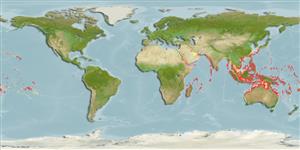分類 / Names
俗名 | 同種異名 | Catalog of Fishes(屬, 種) | ITIS | CoL | WoRMS | Cloffa
Environment: milieu / climate zone / depth range / distribution range
生態學
海洋 礁區魚類; 深度上下限 0 - 50 m (Ref. 9710), usually ? - 20 m (Ref. 5222). 熱帶; 35°N - 35°S, 28°E - 129°W (Ref. 5222)
Indo-Pacific: South Africa to French Polynesia. Not known from the Red Sea, Persian Gulf, nor Asian mainland.
印度-太平洋: 南非至法屬玻里尼西亞。 已知不來自紅海,波斯灣也不亞洲大陸。
Length at first maturity / 大小 / 重量 / 年齡
Maturity: Lm 11.0, range 19 - ? cm
Max length : 36.5 cm TL 雄魚/尚未辨別雌雄; (Ref. 125599); 最大體重: 1.0 kg (Ref. 125599)
背棘 (總數) : 11; 背的軟條 (總數) : 15 - 17; 臀棘: 3; 臀鰭軟條: 8. This species is distinguished by the following characters: greatest body depth 2.8-3.3 in SL; head length 2.3-2.6 in SL; preopercle rounded or subangular, the serrae at angle enlarged; upper edge of operculum almost straight; midlateral part of lower jaw with 2-4 rows of teeth, the inner teeth about twice length of outer ones; gill rakers of first gill arch 6-9 + 14-17; dorsal fin spines third to last subequal, the longest 2.4-3.2 in HL; anal fin spines second and third subequal, 2.1-3.0 in HL and longer than depth of peduncle; caudal fin rounded, peduncle depth 3.2-4.1 in HL; pectoral-fin rays 16-18; lateral-line scales 48-54, in series 98-114. Head, body, and fins pale, are covered with close-set (sometimes coalesced), dark brown or reddish brown spots, the interspaces forming an irregular pale reticulum; pectoral fins are covered with distinct small black spots, largely confined to the rays (the best diagnostic colour character of this species) (Ref. 39231, 89707, 90102).
一系列的大約五條比較深色的斜條紋 , 每個二到五個六角形寬的, 在側邊上重疊了而且從眼放射; 在側邊上的六角形可能合併成短的列。 (參考文獻 37816)
A solitary fish, in coastal and offshore reefs usually in less than 20 m depth (Ref. 90102); also very common in shallow lagoon and semi-protected seaward reefs. Juveniles are common in thickets of staghorn Acropora corals. Feed on crustaceans and fishes. Increase of piscivory with age is observed in this species. Neither opercular spine nor anterolateral glandular grooves with venom gland is present (Ref. 57406). Current information in the table (dangerous fish) do not match; needs verification. Cultured under experimental conditions in the Philippines (Ref. 4757). In the Hong Kong live fish markets (Ref. 27253). It is important to artisanal fisheries because of its abundance in shallow water and caught with handlines, fish traps, and spear (Ref. 39231).
非常常見於潟湖淺灘與半遮蔽的臨海礁石。 稚魚常見於鹿角 Acropora 珊瑚的叢。 吃甲殼動物和魚類。 食魚的食性隨著年齡而增加在這種方面被觀察。 在菲律賓在實驗的情況養殖。 (參考文獻 4757) 在香港活魚販售。 (參考文獻 27253)
Life cycle and mating behavior
成熟度 | 繁殖 | 產卵場 | 卵 | 孕卵數 | 仔魚
印度-太平洋: 南非至法屬玻里尼西亞。 已知不來自紅海,波斯灣也不亞洲大陸。
Heemstra, P.C. and J.E. Randall, 1993. FAO Species Catalogue. Vol. 16. Groupers of the world (family Serranidae, subfamily Epinephelinae). An annotated and illustrated catalogue of the grouper, rockcod, hind, coral grouper and lyretail species known to date. Rome: FAO. FAO Fish. Synop. 125(16):382 p. (Ref. 5222)
IUCN 瀕危狀態 (Ref. 130435: Version 2024-2)
無危 (LC) ; Date assessed: 17 January 2017
人類使用
漁業: 商業性; 養殖: 商業性; 游釣魚種: 是的; 水族館: 公眾的水族館
工具
特別的報告
下載 XML
網路資源
Estimates based on models
Preferred temperature (Ref.
123201): 24.6 - 29, mean 27.8 °C (based on 760 cells).
Phylogenetic diversity index (Ref.
82804): PD
50 = 0.5000 [Uniqueness, from 0.5 = low to 2.0 = high].
Bayesian length-weight: a=0.01202 (0.01061 - 0.01362), b=3.04 (3.02 - 3.06), in cm total length, based on LWR estimates for this species (Ref.
93245).
營養階層 (Ref.
69278): 3.8 ±0.0 se; based on diet studies.
回復力 (Ref.
120179): 高度, 族群倍增時間少於 15個月 (K=0.3-0.6).
Fishing Vulnerability (Ref.
59153): Low vulnerability (24 of 100).
Nutrients (Ref.
124155): Calcium = 48.4 [23.5, 101.6] mg/100g; Iron = 0.721 [0.369, 1.518] mg/100g; Protein = 18.4 [16.9, 19.8] %; Omega3 = 0.132 [0.080, 0.213] g/100g; Selenium = 32.9 [17.0, 64.7] μg/100g; VitaminA = 254 [64, 968] μg/100g; Zinc = 1.37 [0.91, 2.01] mg/100g (wet weight); based on
nutrient studies.
